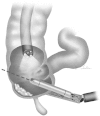Combined Endoscopic and Laparoscopic Surgery
- PMID: 26491405
- PMCID: PMC4593898
- DOI: 10.1055/s-0035-1555005
Combined Endoscopic and Laparoscopic Surgery
Abstract
Benign colon polyps are best treated endoscopically. Colon polyps that are not amenable for endoscopic removals either because they are too large or situated in anatomically difficult locations can pose a clinical dilemma. Traditionally the most common recommendation for these patients has been to offer a colon resection. Although the laparoscopic approach has improved short-term outcomes, morbidities associated with bowel resection are still significant. We may be over treating majority of these patients because of the remote possibility that these polyps may be harboring a cancer. A combined approach using both laparoscopy and colonoscopy (combined endoscopic and laparoscopic surgery) has been described as an alternative to bowel resection in select patients with polyps that cannot be removed endoscopically. Polyp removal using this combined approach may be an effective alternative in select patients.
Keywords: Laparoscopic-assisted endoscopic polypectomy; benign polyps; combined endoscopic and laparoscopic surgery.
Figures






References
-
- Fujishiro M, Goto O, Kakushima N, Kodashima S, Muraki Y, Omata M. Endoscopic submucosal dissection of stomach neoplasms after unsuccessful endoscopic resection. Dig Liver Dis. 2007;39(6):566–571. - PubMed
-
- Zhou P H, Yao L Q, Qin X Y. Endoscopic submucosal dissection for colorectal epithelial neoplasm. Surg Endosc. 2009;23(7):1546–1551. - PubMed
-
- Franklin M E Jr, Díaz-E J A, Abrego D, Parra-Dávila E, Glass J L. Laparoscopic-assisted colonoscopic polypectomy: the Texas Endosurgery Institute experience. Dis Colon Rectum. 2000;43(9):1246–1249. - PubMed
-
- Beck D E, Karulf R E. Laparoscopic-assisted full-thickness endoscopic polypectomy. Dis Colon Rectum. 1993;36(7):693–695. - PubMed
-
- Guller U, Jain N, Hervey S, Purves H, Pietrobon R. Laparoscopic vs open colectomy: outcomes comparison based on large nationwide databases. Arch Surg. 2003;138(11):1179–1186. - PubMed
Publication types
LinkOut - more resources
Full Text Sources
Other Literature Sources

